Keel Laid For Solent Ro-Ro
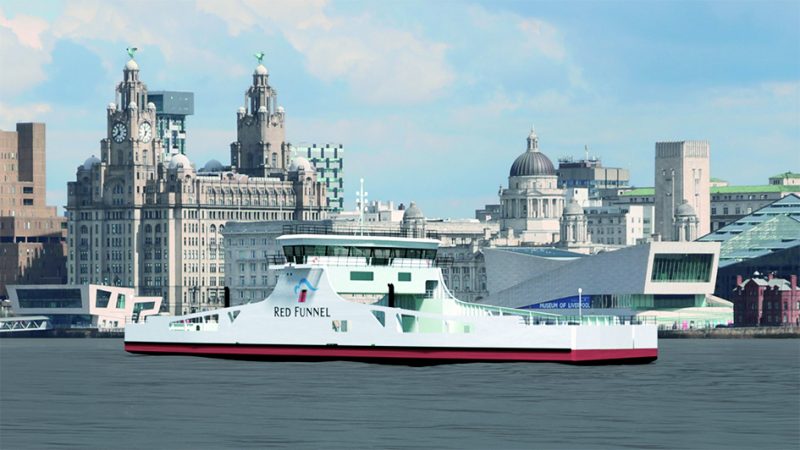
Red Funnel Ferries’ new Ro-Ro ferry Red Kestrel (artist’s impression above) had her keel laying ceremony at the Cammell Laird Shipyard in Birkenhead on the afternoon of 31st May, witnessed by 300 invited guests. Karen George, wife of Red Funnel’s Chairman, had the honour of pushing the button to lay down the first section of the keel, accompanied by the Rt. Hon. Alok Sharma MP, Minister of State for Employment at Department of Work and Pensions, John Syvret CBE, CEO of Cammell Laird, and Kevin George, Chairman of Red Funnel Group. The milestone event was followed by a keynote address from the Minister of State as part of his visit to businesses in the North West of England. In time honoured tradition and as a symbol of good luck, coins, in this case an Isle of Wight silver sixpence dating from 1811 and a halfpenny from 1792 were placed under the keel block. Both coins will eventually be recovered and presented to the Red Kestrel when she enters service. The £10 million order was announced in February 2018 and will be Red Funnel’s first dedicated ro-ro freight ship, providing additional year-round freight capacity on the Southampton-East Cowes route which currently handles 53% of all freight movements across the Solent. At 74m in length, she will provide 265 lanemetres of roll-on/roll-off freight capacity, will carry up to 12 passengers and will be powered by two Cummings Tier III diesels connected to two Rolls Royce azimuth thruster. The ship is scheduled to enter service in 2019 and will be christened Red Kestrel. Earlier, on 15th May, Red Funnel awarded a major contract to Isle of Wight based Stoneham Construction Ltd. to complete phase 1 of the company’s East Cowes terminal redevelopment. Work at the site of the former Trinity House maintenance depot involves levelling the area, adding suitable drainage, black topping the surface and adding lane markings. It is expected the project will be completed and the site commissioned for operational use by late July 2018. At the seaward side of this site will be built a new layby berth where the Ro-Ro vessel Red Kestrel can lay over between freight sailings.
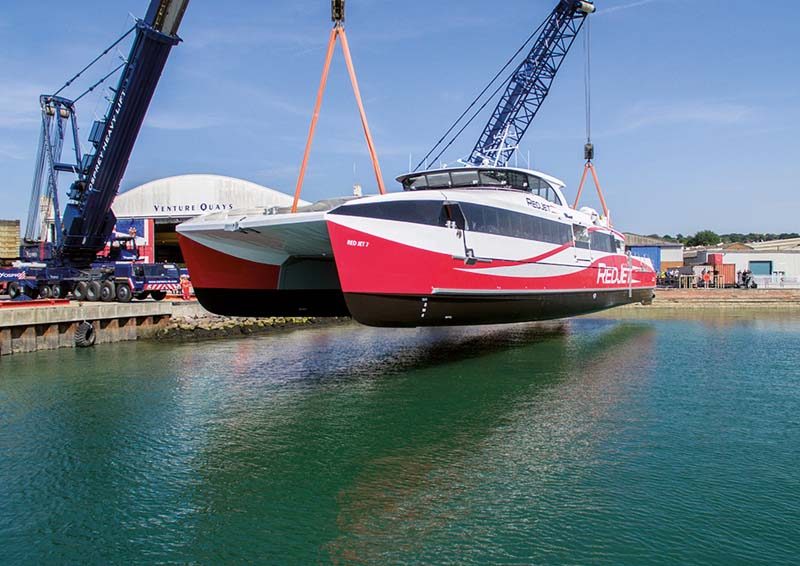
On the afternoon of 6th June the Red Jet 7 was craned into the water at Wight Shipyard, East Cowes prior to completion and sea trials (above). The naming ceremony is scheduled for 24th July. Wightlink’s new flagship, the Victoria of Wight, is also expected to arrive in home waters in July, all being well. She is seen above during sea trials.
Green Light For Takeover
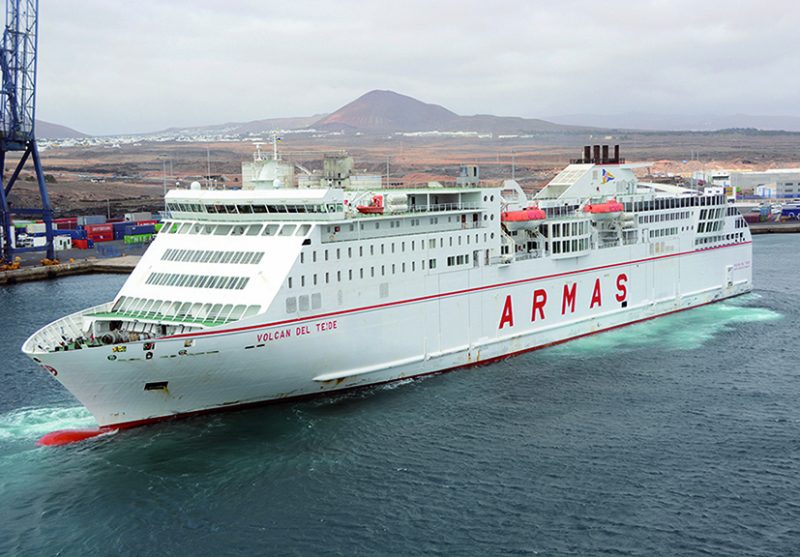
Naviera Armas has been given the go-ahead by the National Commission of Markets and Competition (CNMC) to acquire compatriot ferry operator Trasmediterranea, but ARMAS will have to comply with a series of conditions. According to the CNMC, the sale posed risks a monopoly situation, therefore Naviera Armas has to accept the introduction to the Motril-Melilla route of German operator FRS Iberia, as well as on the Huelva-Canary Islands link (including the inter-island services) from the beginning of July using the existing ships. These routes had until now been operated by Armas and FRS effectively takes them over completely. FRS will charter the Armas-owned ferries Volcan De Tauce (9,087gt/built 1995) for the Motril-Melilla operation and the 29,514gt/2011 built Volcan de Teide (above) for the Huelva-Canary Islands route. The expansion of the FRS network is part of the company’s strategic vision of continuous growth and now sees them operating 9 vessels with 800 dedicated personnel in Spain and Morocco.

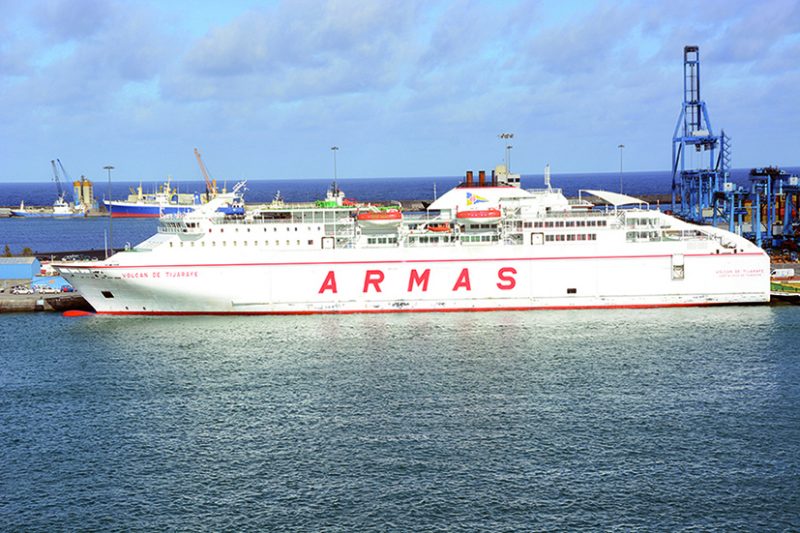
Back in October the Acciona group had reached an agreement for the sale of its 92.7% stake in Trasmediterránea to Naviera Armas for €260.4 million but had to await the findings of the CNMC. Naviera Armas is also set to operate the revived Canary Islands-Madeira route using the 19,976gt/2008 built Volcan de Tijarafe (above) from 2nd July until September on behalf of ENM (Empresa de Navegação Madeirense). The Regional Government Council of Madeira awarded the service to ENM who will operate it for 3 years with a subsidy of €9 million. The route previously ran until January 2012 when Naviera Armas decided to pull the plug on the service. The Trasmediterranea vessel Villa de Teror has also been linked to this service. The company is also now operating the former P&O Ferries/Viking Line Incat built fast ferry Express in the Canary Islands.
Fleet Expansion For Brittany Ferries
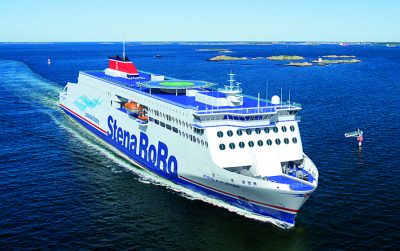
On 25th May Brittany Ferries confirmed the charter of two brand new 42,400gt, 215m long, 27.8m beam, 6.4m draught and 22 knot cruise-ferries to serve its long-haul UK to Spain routes. Both ships will be built at the Avic International Weihai shipyard in China, with the first arriving in time for the 2021 holiday season. The latest investment underlines the company’s commitment to Portsmouth and to its Spanish routes and the news comes after work began this spring on a brand new LNG cruise ferry for Portsmouth-Caen, the Honfleur. All three newbuilds will be registered under the French flag and will be crewed by French seafarers. Together the trio will spearhead a wide-ranging, five-year fleet-renewal and modernisation programme worth around £400 million. In 2017 the company operated 844 sailings on routes from Portsmouth, Poole and Plymouth to Santander (Cantabria) and Bilbao (Basque Country), carrying 331,000 passengers and 150,000 cars. That was around 80% more than ten years earlier. Around 40,000 freight units were also shipped from the UK to Spain.
The new ships are being chartered from Stena Ro-Ro and are two representatives of Stena’s new generation of state-of-the-art ‘E-Flexer’ ships (artist’s impression above). Both will be LNG-ready and promise a combination of luxury and Spanish style after modifications to suit the Brittany Ferries brand and trademark elegant decor. Each ship will offer 3 spacious passenger decks featuring boutiques, a café, restaurant, bar and an exclusive club lounge. Around 300 en-suite cabins will cater for approximately 1,000 passengers and many will be adapted for customers with disabilities, as well as those travelling with their pet dog or cat. There will also be 36 cabins for freight drivers. Of the E-Flexer ships already announced, 3 will go to Stena Line (Irish Sea), 2 to Brittany Ferries (Portsmouth – 5 year bareboat charter with purchase option), one to DFDS (Dover-Calais 10 year bareboat charter) plus two further newbuilds yet to be allocated. On 8th June the first E-Flexer was confirmed as a replacement for the Superfast X on the Holyhead-Dublin service. The 27,541gt/1992 built Normandie operated a Portsmouth-Cherbourg sailing on 4th June prior to spending a few days in port for attention to a bow thruster unit.
Lake Constance Newbuild
A new ferry hailed as the first inland passenger ship in Europe with LNG gas engines, is being built in Germany for delivery in 2020. The 82.37m long and 13.4m wide ferry is being built in sections at the Pella Sietas shipyard in Hamburg for the Stadtwerke Konstanz in southern Germany. In spring 2019 the sections will be transported by waterway and road from Hamburg to Fussach on Lake Constance in Austria where she will be assembled ready for delivery in 2020 onto the Constance-Meersburg route. The newbuild will be equipped with two of MTU’s new 8-cylinder Series 4000 single fuel LNG gas engines producing 756kW apiece and driving two Voith Schneider propellers. The engines are based on MTU’s proven 4000 Series diesels for workboat. The vessel will have the same external dimensions as her 2009 predecessor, Lodi, which is driven by 8-cylinder MTU Series 4000 diesels, and will have a service speed of 12 knots. Stadtwerke Konstanz’s ships carry 4.2 million passengers and about 1.5 million vehicles a year.

Capacity Reshuffle
P&O Ferries announced on 14th May that it planned to increase capacity on its 15-hour Zeebrugge-Teesport route by almost 25% within the coming month in order to create a gateway to Scotland via the north-eastern port. The company currently carries more than 100,000 freight units a year to Teesport from its continental hub at Zeebrugge. The 12 sailings a week have been provided by the 25,586gt/2011 built Bore Song and the 10,471gt/1999 built Mistral. At the end of May the 21,171gt/2004 built Stena Carrier moved to P&O’s Teesport-Europoort route to release the 18,205gt/1999 built Estraden to replace the Mistral on the Teesport-Zeebrugge service. This reshuffle boosted capacity on the Zeebrugge service by the desired 25% and follows the withdrawal of the Rosyth-Zeebrugge ferry service. The Mistral now looks set to act as a refit relief vessel on the Irish Sea 2nd June-21st August 2018. The Pride of Kent returned to Calais on 30th May from repairs at Dunkerque following her grounding in Calais harbour on 10th December that caused significant damage to a rudder, propeller shaft and hub plus a gearbox. The 30,635gt/1992 built ship was also overhauled during her spell of inactivity. At the end of May a business news source indicated that P&O Ferries are preparing to order 2 new Ro-Pax ships for Dover-Calais, representing a €400 million investment with delivery 2021/22. Time will tell.




Comments
Sorry, comments are closed for this item